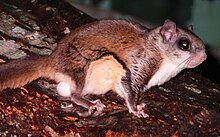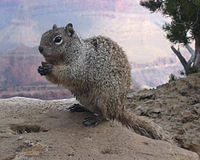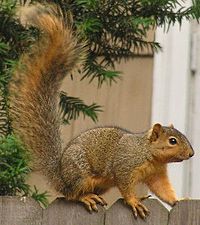Southern flying squirrel: Difference between revisions
m create paragraph; change to sentence case mammal species common name as specified in WP:MOS |
|||
| Line 37: | Line 37: | ||
{{Reflist}} |
{{Reflist}} |
||
{{-}} |
{{-}} |
||
These squirells have really close eyes with long hair.There good at baseball and has a hot girlfriend |
|||
==References== |
==References== |
||
Revision as of 19:45, 4 December 2012
| Southern flying squirrel | |
|---|---|

| |
| Scientific classification | |
| Kingdom: | |
| Phylum: | |
| Class: | |
| Order: | |
| Family: | |
| Tribe: | |
| Genus: | |
| Species: | G. volans
|
| Binomial name | |
| Glaucomys volans | |
| File:Southern flying squirrel distribution.jpg | |
| Southern flying squirrel range based on the IUCN distribution map. | |
| Synonyms | |
|
[Mus] volans Linnaeus, 1758 | |
The southern flying squirrel (Glaucomys volans) is one of two species of the genus Glaucomys, the only flying squirrels found in North America (the other is the somewhat larger northern flying squirrel G. sabrinus). It is found in deciduous and mixed woods in the eastern half of North America, from southeastern Canada, to Florida, USA. Disjunct populations of this species also have been recorded from the highlands of Mexico, Guatemala and Honduras.
Description and ecology

Southern flying squirrels have grey brown fur on top with darker flanks and are a cream color underneath. They have large dark eyes and a flattened tail. They have a furry membrane called a patagium which extends between the front and rear legs, used to glide through the air.
Southern flying squirrels feed on fruit and nuts from trees such as red and white oak, hickory and beech. They store food, especially acorns, for winter consumption. They also dine on insects, buds, mushrooms, mycorrhizal fungi, carrion, bird eggs and nestlings and flowers. Predators include snakes,[3] owls, hawks and raccoons. Domestic house cats can be dangerous to these animals. Although graceful in flight, they are particularly vulnerable on the ground.
Both in the wild and in captivity they can produce two litters each year (with 2-7 young per litter). The gestation period is approximately 40 days. Young are born without fur or any capabilities of its own. Their ears open at 2 to 6 days old, and fur grows in by 7 days. Their eyes don't open until they are 24–30 days old. Parents leave their young 65 days after they are born. The young then become fully independent at around 120 days of age.
Southern flying squirrels show substantial homing abilities, and can return to their nests if artificially removed to distances of up to a kilometre. Their home ranges may be up to 40,000 square meters for females and double that for males, tending to be larger at the northern extreme of their range.
Exposure to southern flying squirrels has been linked to cases of epidemic typhus in humans.[4] Typhus spread by flying squirrels is known as "sylvatic typhus" and the Centers for Disease Control and Prevention has documented a total of 39 such cases in the U.S. from 1976 to 2001.[5] The squirrel acts as host to the Rickettsia prowazekii bacteria and transmission to humans is believed to occur via lice or fleas.
Footnotes
- ^ Template:IUCN2008
- ^ Howell, A.H. 1918. Revision of the American flying squirrels. North American Fauna No. 44, U.S. Dept. Agr. Biological Survey. Washington.
- ^ E.g.rat snakes, namely Elaphe obsoleta: Medlin & Risch (2006)
- ^ eMedicine - Typhus: Article Excerpt by Jason F Okulicz
- ^ Sylvatic Typhus Fact Sheet, Pennsylvania Department of Health Downloaded on 24 January 2010.
These squirells have really close eyes with long hair.There good at baseball and has a hot girlfriend
References
- Template:IUCN2006
- Arbogast, B. S. (1999): Mitochondrial DNA phylogeography of the New World flying squirrels (Glaucomys): implications for Pleistocene biogeography. Journal of Mammalogy 80: 142-155.
- Fox, D. & Mulheisen, M. (1999): Animal Diversity Web - Glaucomys volans. Accessed May 20, 2005.
- Fridell, R. A. & Litvaitis, J. A. (1991): Influence of resource distribution and abundance on home-range characteristics of southern flying squirrels. Canadian Journal of Zoology 69: 2589-2593.
- Medlin, E. C. & Risch, T. S. (2006) An experimental test of snake skin use to deter nest predation [English with Spanish abstract]. Condor 108(4): 963-965. DOI:10.1650/0010-5422(2006)108[963:AETOSS]2.0.CO;2 HTML abstract Summary at conservationevidence.com
- Mitchell, L. R.; Carlile, L. D. & Chandler, C. R. (1999): Effects of southern flying squirrels on nest success of red-cockaded woodpeckers. Journal of Wildlife Management 63: 538-545.
- Sawyer, S. L. & Rose, R. K. (1985): Homing in and ecology of the southern flying squirrel Glaucomys volans in southeastern Virginia. American Midland Naturalist 113: 238-244.
- Stapp, P.; Pekins, P. J. & Mautz, W. W. (1991): Winter energy-expenditure and the distribution of southern flying squirrels. Canadian Journal of Zoology 69: 2548-2555.
- Stone, K. D.; Heidt, G. A.; Baltosser, W. H. & Caster, P. T. (1996): Factors affecting nest box use by southern flying squirrels (Glaucomys volans) and gray squirrels (Sciurus carolinensis). American Midland Naturalist 135: 9-13.
- Stone, K. D.; Heidt, G. A.; Caster, P. T. & Kennedy, M. L. (1997): Using geographic information systems to determine home range of the southern flying squirrel (Glaucomys volans). American Midland Naturalist 137: 106-111.
- Taulman, J. F. (1999): Selection of nest trees by southern flying squirrels (Sciuridae: Glaucomys volans) in Arkansas. Journal of Zoology 248: 369-377.
- Taulman, J. F.; Smith, K. G. & Thill, R. E. (1998): Demographic and behavioral responses of southern flying squirrels to experimental logging in Arkansas. Ecological Applications 8: 1144-1155.
- Thomas, R. B. & Weigl, P.D. (1998). Dynamic foraging behavior in the southern flying squirrel (Glaucomys volans): test of a model. American Midland Naturalist 140: 264-270.




